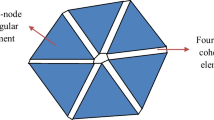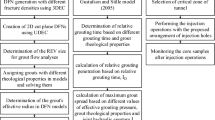Abstract
In the practice of grouting of fractured rock, currently, empirical methods are used. Amongst them, the GIN method is popular mostly in Europe and has been tried in many projects. The concept of this method is to limit the combination of pressure and injected volume to a specific grout intensity number in order to control the energy induced in the rock fractures and to avoid uplift. However, difficulties in employing this method have been reported, which are mainly due to uncertainties in recognizing the distance of grout penetration and the state of the fractures during grouting and at the completion grouting. In this paper, the purpose has been examining the applicability of the GIN method by defining the characteristic curve of the P·V diagram (referred to here as the hyperbola) and suggesting appropriate completion criteria based on the radius of grout spread around the borehole. This will provide the chance to assign a permitted level of fracture deformation (or jacking) to the GIN by considering the formulation of fracture deformation based on grout propagation in a previously developed theoretical approach by Stille et al. (Geotech Geol Eng 30:603–624, 2012) as a part of the Real Time Grouting Control Method. Thus, in attaining the hyperbola, the identified radius of grout spread is achieved and the resulting fracture deformation at this completion point can be beneficial in improving penetrability. However, if the full extent of this deformation extends beyond the grouted zone, part of the fracture may remain un-grouted, and this will affect the sealing efficiency of the grouting program. This may be continued by selecting a smaller GIN and reducing the grouting pressure as the real time pressure–volume plot moves along the hyperbola, which will bring the fracture back to its initial state as grouting approaches the completion point, i.e. when the grout has spread to the desired distance. This hypothesis has been examined against the grouting works performed in three different real projects, for which the grouting parameters can be determined from the available grouting records. It is concluded that the GIN used in practice was much higher than the theoretically estimated values obtained through the proposed analytical solution. Furthermore, in the grouting of fractures close to the surface, the radius of grout spread impacts the GIN significantly, and only a limited grouting pressure is applicable, thus in using split spacing technique in such circumstances, different GINs should be selected for different sets of boreholes to obtain enough propagation at the maximum applicable pressure. The introduced analytical solution introduced in this paper can be a useful procedure for designing the GIN based on the grout spread. Nevertheless, it becomes complicated in dealing with fracture deformation. In a difficult grouting case where the demand for sealing is high, the recommendation is to use the proposed theoretical approach, which provides detailed information during the actual grouting procedure, by estimation of the radius of grout spread and the state of the fracture in real time.













Similar content being viewed by others
References
Bonin GR, Rombough VT, Carter TG, Jefferies MG (2012) Towards better injection control and verification of rock grouting. In: Johnsen LF, Bruce DA, Byle MJ (eds) Grouting and deep mixing (GSP 228), vol 2. ASCE, New Orleans, pp 1460–1471. doi:10.1061/9780784412350.0122
Brantberger M, Stille H, Eriksson M (2000) Controlling grout spreading in tunnel grouting analyses and development of the GIN-method. Tunnel Undergr Space Technol 15(4):343–352
Bruno A (2009) Grouting operation monitoring and analysis of the “Real Time Grouting Control” method. KTH, Stockholm
Carter TG, Dershowitz W, Shuttle D, Jefferies M (2012) Improved methods of design for grouting fractured rock. In: Johnsen LF, Bruce DA, Byle MJ (eds) Grouting and deep mixing (GSP 228), vol 2. ASCE, New Orleans, pp 1472–1483. doi:10.1061/9780784412350.0123
El Tani M (2012) Grouting rock fractures with cement grout. Rock Mech Rock Eng 54(4):547–561
ENGINEERS UA (2004) Grouting methods and equipment. Unified Facilities Criteria (UFC)
Ewert F (1996, February and April) The GIN principle-a helpful method for rock grouting? Part 1 and 2. Int Water Power Dam Constr 48(2):17–19, 36–40
Ginther C, White B (2012) Foundation preparation and seepage barrier installation at the Wyaralong dam construction project. In: Johnsen LF, Bruce DA, Byle MJ (eds) Grouting and deep mixing (GSP 228). ASCE, New Orleans, pp 1276–1286. doi:10.1061/9780784412350.0104
Gothäll R, Stille H (2009) Fracture dilation during grouting. Tunn Undergr Space Technol 24:126–135. doi:10.1016/j.tust.2008.05.004
Gustafson G, Stille H (2005) Stop criteria for cement grouting. Felsbau 23(3):62–68
Gustafson G, Claesson J, Fransson Å (2013) Steeting parameters for rock grouting. Appl Math. doi:10.1155/2013/269594
Håkansson U, Hässler L, Stille H (1992) Rheological properties of microfine cement grouts. Tunn Undergr Space Technol 7(4):453–458
Hässler L (1991) Grouting of rock-simulation and classification-PhD thesis. Royal Institute of Technology, Stockholm
Heinze W (2012) Dams founded on dispersive soils and rocks drilling and grouting under difficult conditions. In: Johnsen LF, Bruce DA, Byle MJ (eds) Grouting and deep mixing (GSP 228). ASCE, New Orleans, pp 1134–1146. doi:10.1061/9780784412350.0094
Hernqvist L, Einarsson V, Höglund A (2014) Does one fracture dominate the borehole transmissivity? In: Rock Mechanics Meetings (Bergmekanikdag). BEFO, Stockholm, pp 115–126
Kettle C, Brown M, Vrba V, Walbancke J, Rowland A (2012) Carno dam: case history of investigation and remedial works. In: Johnsen LF, Bruce DA, Byle MJ (eds) Grouting and deep mixing (GSP 228). ASCE, New Orleans, pp 1158–1186. doi:10.1061/9780784412350.0096
Kobayashi S, Stille H, Gustafson G, Stille B (2008) Real time grouting control method, development and application using Äspö HRL data. Swedish Nuclear Fuel and Waste Management Co (SKB), Stockholm
Lipscomb G, Denn M (1984) Flow of Bingham fluids in complex geometries. J Non Newton Fluid Mech 14:337–346
Lombardi G (1996) Selecting the grouting intensity. Int J Hydropower Dams 3(4):62–66
Lombardi G, Deere D (1993) Grouting design and control using the GIN principle. Int Water Power Dam Construct 45(6):15–22
Rafi J, Stille H (2014) Control of rock jacking considering spread of grout and grouting pressure. Tunn Undergr Space Technol 40:1–15. doi:10.1016/j.tust.2013.09.005
Rafi J, Stille H (2015) Basic mechanism of elastic jacking and impact of fracture aperture change on grout spread, transmissivity and penetrability. Tunn Undergr Space Technol 49:174–187. doi:10.1016/j.tust.2015.04.002
Saedi O, Stille H, Torabi S (2013) Numerical and analytical analyses of the effects of different joint and grout properties on the rock mass groutability. Tunn Undergr Space Technol 38:11–25. doi:10.1016/j.tust.2013.05.005
Steyn G, Mouton D (2012) Grouting experience in variable geological conditions in Southern Africa. In: Johnsen LF, Bruce DA, Byle MJ (eds) Grouting and deep mixing (GSP 228). ASCE, New Orleans, pp 1147–1157. doi:10.1061/9780784412350.0095
Stille H, Gustafson G, Hassler L (2012) Application of new theories and technology for grouting of dams and foundations on rock. Geotech Geol Eng 30:603–624. doi:10.1007/s10706-012-9512-7
Tsuji M, Holmberg M, Stille B, Rafi J, Stille H (2012) Optimization of grouting procedure with RTGC and data from trialgrouting at Citiybanan in Stockholm. SKB, Stokholm
Willson B (2012) Practice, perspective and trends in US rock grouting. In: Johnsen LF, Bruce DA, Byle MJ (eds) Grouting and deep mixing (GSP 228). ASCE, New Orleans, pp 25–73. doi:10.1061/9780784412350.0002
Author information
Authors and Affiliations
Corresponding author
Rights and permissions
About this article
Cite this article
Rafi, J.Y., Stille, H. Applicability of Using GIN Method, by Considering Theoretical Approach of Grouting Design. Geotech Geol Eng 33, 1431–1448 (2015). https://doi.org/10.1007/s10706-015-9910-8
Received:
Accepted:
Published:
Issue Date:
DOI: https://doi.org/10.1007/s10706-015-9910-8




